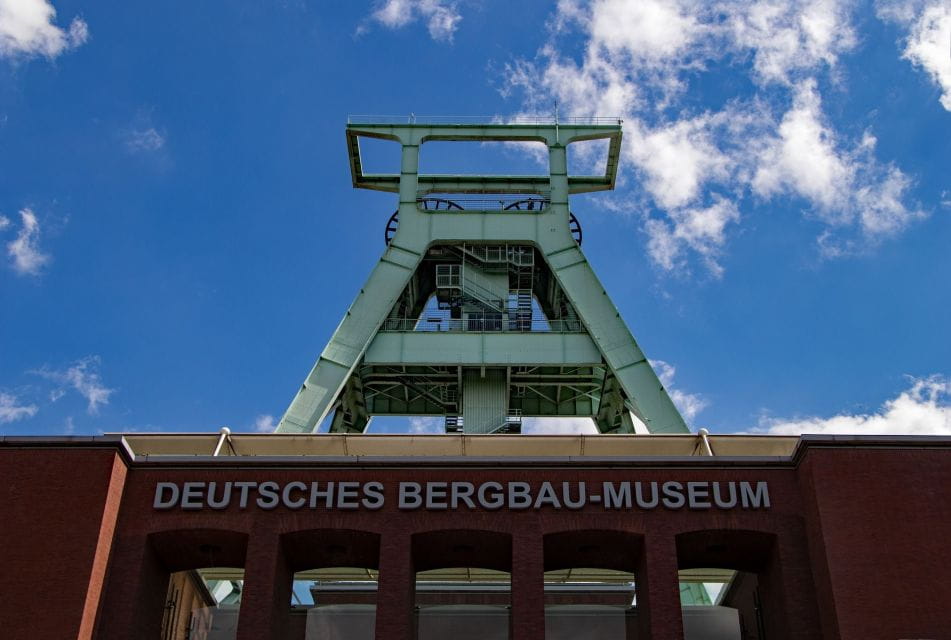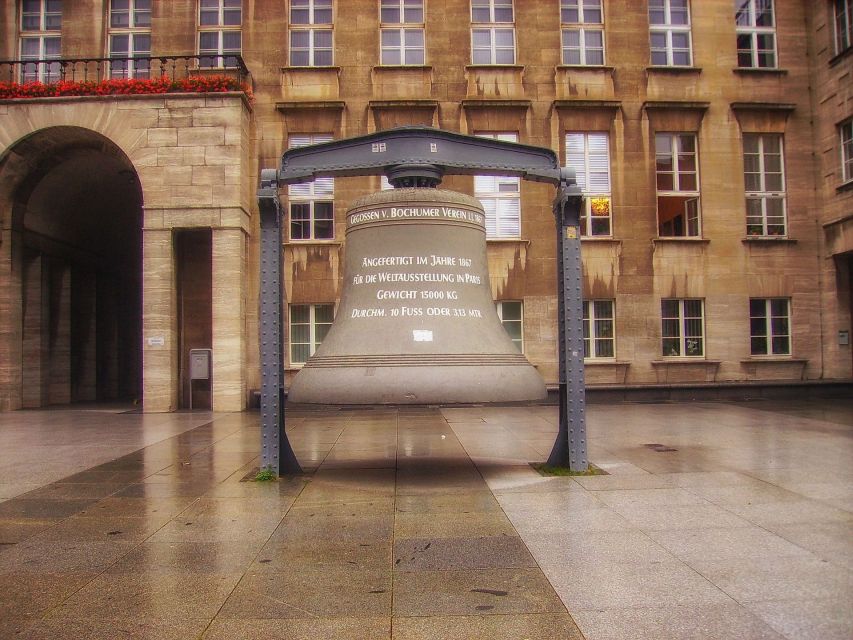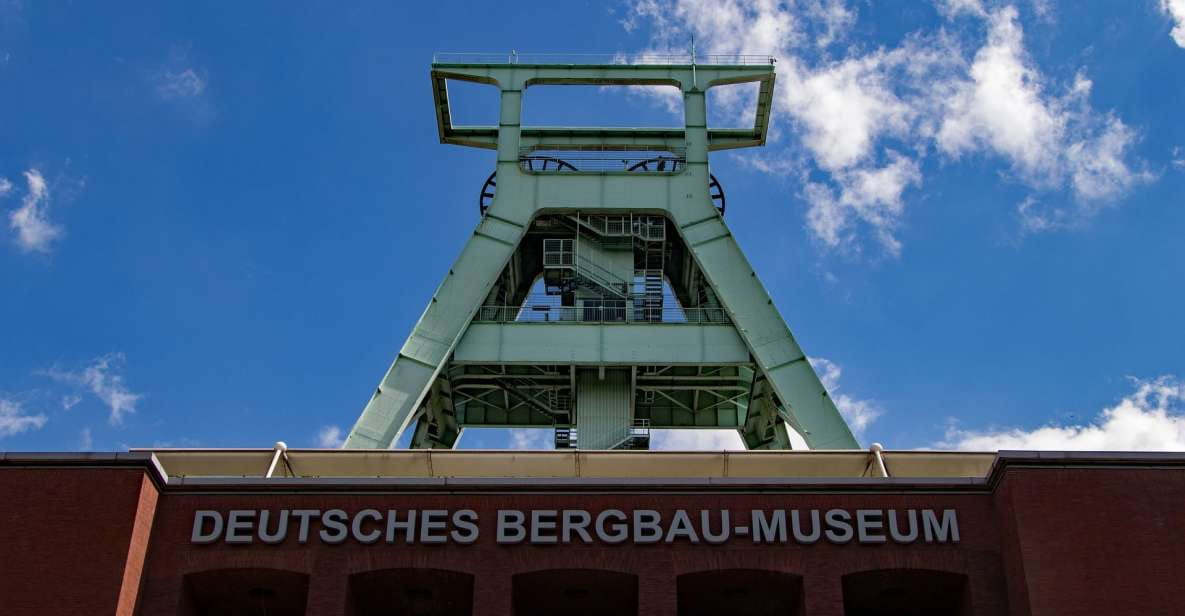Bochum’s transformation from a small town to an industrial powerhouse is a fascinating tale worth exploring. Through a guided walking tour with a professional guide, visitors can dive into the city’s rich history. From its coal mining and steel industry roots to its resilient post-war reconstruction, the tour offers an immersive experience in Bochum’s cultural and architectural heritage. Iconic landmarks, like the Paulus Church and Propsteikirche, provide a glimpse into the lives of influential figures who shaped the city’s past. Whether you’re interested in industrial history or architectural marvels, this tour promises to uncover Bochum’s hidden gems and leave you eager to learn more.
Key Points

- Discover Bochum’s transformation from a small town to an industrial hub, exploring its coal mining and steel industry heritage with a professional guide.
- Marvel at the city’s iconic architecture, including the Paulus Church and Altes Brauhaus Rietköetter, while learning about Bochum’s post-war reconstruction efforts.
- Explore the history of the Propsteikirche St Peter and St Paulus, a medieval church founded by Charlemagne, as a highlight of the guided tour.
- Uncover the stories of notable figures, such as Fritz Husemann, who played a crucial role in the non-violent resistance movement against the Nazi regime.
- Customize the walking tour to suit your interests, whether it’s exploring Bochum’s industrial heritage in-depth or focusing on the city’s architectural and cultural landmarks.
Bochum’s Cultural and Industrial Heritage

Bochum’s transformation from a small town of 4,500 inhabitants to a thriving city of over 300,000 is a testament to its rich cultural and industrial heritage.
Once known for its coal mining and steel industries, the city has skillfully blended its industrial past with a vibrant cultural scene.
Iconic architectural landmarks, like the Karl Roth building and the Paulus Church, stand as reminders of Bochum’s storied history.
The city has also weathered the challenges of wartime, emerging with a renewed spirit exemplified by its reconstruction efforts.
Today, Bochum proudly celebrates its legacy, offering visitors a unique opportunity to explore its industrial roots and cultural renaissance.
You can also read our reviews of more tours and experiences in Bochum.
Guided Walking Tour Experience

Offering a comprehensive exploration of Bochum’s cultural and industrial heritage, the guided walking tour provides visitors with a captivating two-hour experience led by a knowledgeable local guide. Available in both English and German, the tour allows guests to explore the city’s remarkable transformation from a small town to a thriving industrial hub.
Key highlights include:
- Discovering the legacy of coal mining and steel industries that shaped Bochum’s identity.
- Admiring the city’s iconic architecture, including the Paulus Church and the Altes Brauhaus Rietköt
ter.
Learning about the city’s reconstruction efforts after World War II.
Exploring the historic Propsteikirche St Peter and St Paulus, founded in 785 by Charlemagne.
Customizable to suit the interests of each group, the guided walking tour offers an engaging and immersive way to experience Bochum’s rich history and culture.
Exploring Coal Mining and Steel Industries

Deeply rooted in Bochum’s industrial heritage, the coal mining and steel industries have profoundly shaped the city’s identity and urban landscape.
As part of the guided walking tour, visitors can discover the legacy of these vital sectors that drove Bochum’s transformation from a small town to a thriving industrial hub.
The tour takes you through the city’s former mining districts, where you’ll uncover the impressive infrastructure and architectural remnants of this bygone era.
You’ll also learn how the steel industry fueled Bochum’s rapid growth, leaving an indelible mark on its skyline and built environment.
This exploration offers a unique window into the city’s industrial past and its enduring influence on Bochum’s present-day character.
Iconic Architecture and Reconstruction Efforts
Beyond its industrial heritage, Bochum’s cityscape is defined by a remarkable collection of iconic architecture that showcases the city’s resilience in the face of wartime devastation. From the Karl Roth building’s striking modernist design to the timeless grandeur of the Paulus Church, the city’s architectural landmarks bear witness to its reconstruction efforts following the destruction of World War II.
The Propsteikirche St Peter and St Paulus, a medieval church founded in 785 by Charlemagne.
The Altes Brauhaus Rietköter, one of the oldest houses in Bochum, dating back to 1630.
The city’s vibrant public squares, where modern structures stand in harmonious contrast to historic buildings.
The innovative urban planning that has transformed Bochum into a model of post-war regeneration.
Propsteikirche St Peter and St Paulus
The Propsteikirche St Peter and St Paulus was founded in 785 by Charlemagne.
It stands as a testament to Bochum’s enduring religious and cultural heritage as a medieval church.
As one of the highlights of the guided walking tour, visitors can explore the church’s remarkable architecture and learn about its pivotal role in Bochum’s development over the centuries.
The Propsteikirche has witnessed the city’s transformation from a small town to a thriving industrial hub, and its continued presence serves as a tangible link to the past, reminding residents and visitors alike of Bochum’s deep-rooted traditions.
Altes Brauhaus Rietköetter and Its History
One of the oldest houses in Bochum, the Altes Brauhaus Rietk??etter dates back to 1630, providing a glimpse into the city’s rich history and enduring architectural legacy.
Constructed in the early 17th century, the Altes Brauhaus Rietk??etter is a prime example of traditional German brewery architecture.
Visitors can explore the building’s well-preserved interior, which features original wooden beams and an authentic brew house.
The brewery’s long history is intertwined with Bochum’s industrial development, as it played a vital role in the city’s economic and cultural growth.
Today, the Altes Brauhaus Rietk??etter stands as a testament to Bochum’s enduring heritage, offering a glimpse into the city’s past and its transformation over the centuries.
Fritz Husemann’s Non-Violent Resistance Story
Fritz Husemann, a member of the Reichstag, played a crucial role in the non-violent resistance movement that sought to challenge Nazi oppression in Bochum.
As part of the walking tour, visitors will learn about Husemann’s courageous story. He was a member of a non-violent resistance group that actively opposed the Nazi regime’s policies.
Despite the risks, Husemann and his fellow activists peacefully protested and distributed anti-Nazi literature in the city. Their brave actions inspired others to stand up against the totalitarian government.
Today, Husemann’s legacy serves as a powerful reminder of the importance of civic engagement and non-violent resistance in the face of tyranny.
Customizing the Tour With the Local Guide
Visitors can customize the guided walking tour with the local guide to suit their interests and preferences. The tour can be tailored to focus on specific aspects of Bochum’s rich history and architecture, allowing for a more personalized experience.
The guide can help visitors:
- Delve deeper into the city’s industrial heritage and its impact on the local community.
- Explore the city’s post-war reconstruction efforts and the challenges faced.
- Discover the stories behind the iconic buildings and landmarks, such as the Propsteikirche St Peter and St Paulus.
- Focus on the lives of notable figures, like Fritz Husemann, and their contributions to Bochum’s history.
This flexibility ensures that each visitor can create a tour that resonates with their unique interests and provides a truly immersive exploration of Bochum.
Frequently Asked Questions
How Much Time Do We Have for the Walking Tour?
The walking tour lasts 2 hours. It’s a private group experience led by a professional guide, who’ll show you the city’s cultural and industrial highlights.
Can We Take Photos During the Tour?
Yes, guests are generally encouraged to take photos during the walking tour. The guide will provide information about the sights and allow ample time for participants to capture the city’s architecture and cultural highlights.
What Kind of Terrain Can We Expect on the Walking Route?
The walking route likely covers a mix of paved streets and sidewalks, with some uneven terrain or cobblestones in the historic district. Comfortable walking shoes are recommended to navigate the varied surfaces and terrain during the tour.
Is the Tour Wheelchair/Stroller Accessible?
The tour route is primarily on paved city streets and sidewalks, making it wheelchair and stroller accessible. However, visitors should check with the guide about any potential challenges or alternative arrangements for those with mobility needs.
Can We Stop for Refreshments During the Tour?
Yes, the tour typically includes a stop at a local cafe or pub for refreshments. Participants can enjoy a break and sample some traditional German fare during the 2-hour walking experience.
Recap
Bochum’s guided walking tour offers visitors a unique opportunity to explore the city’s remarkable transformation.
From its industrial roots to its cultural renaissance, the tour brings the past to life, showcasing iconic landmarks and the stories of influential figures.
Customizable to individual interests, this immersive experience provides an insightful glimpse into Bochum’s rich heritage and resilience, leaving a lasting impression on all who embark on this journey through time.
